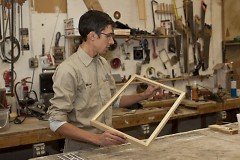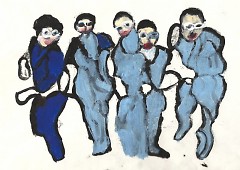Connect with Michael DeMaagd Rodriguez through his Avenue for the Arts profile, learn more about Visionaries + Voices on their website, and be sure to check out Heartside Gallery. See what Have Company is up to by stopping in at 136 South Division Ave or visiting the store online and keep up with Art.Downtown. on the Avenue for the Arts website or on Facebook.
“I don’t identify primarily as an artist, but I do consider myself an active part of the "art ecosystem" in roles as a collector, a builder, and most recently, as a curator.” These are the words of Michael DeMaagd Rodriguez, who I had the opportunity to speak with about his upcoming show “Masks & Faces” at Have Company during Art.Downtown. DeMaagd Rodriguez is a 2010 graduate of Calvin College with degrees in Spanish, Studio Art and Urban Studies. He currently works for Grand River Builders, specializing in historic building restoration, which may factor into his ambitions of working towards a Master of Architecture degree. “My wife Megan and I actively collect original artworks, mostly from local artists,” DeMaagd Rodriguez says. “I also support the work of many of these artists by building them custom frames, painting panels, shipping crates, etc.”
After seeing the MFA thesis exhibition of Salvador Jimenez at Kendall College of Art and Design last spring, DeMaagd Rodriguez has become increasingly interested in masks, noting that our faces are usually our most significant means of identifying and communicating. Yet facial language is not equally accessible or comfortable for everyone. “The six artists shown in Masks & Faces have consistently made work that prominently features the face, though in quite different ways,” DeMaagd Rodriguez explains. His goals as a curator involve manipulating the communication between different artists and works by accentuating their similarities and differences, both formally and conceptually. “My question in organizing this exhibitions is simply, what does each artist's interpretation of a face, or a mask, tell us about how they see themselves and others?”
Grand Rapids has defined 2015 as the Year of Arts + Access. For DeMaagd Rodriguez, that means both celebration and education. The celebration comes from the affirmation of the experiences of people whose stories are, for a variety of reasons, not well-recognized. The education component provides an opportunity for the general public to learn about the experiences of others. DeMaagd Rodriguez believes that in order to accomplish this, we must approach the event with a sense of humility and true willingness to listen. “Art has unique, transformative means of bringing that out,” he says. “It gives us the power to remove ourselves from the self-conscious and allows us to discover something new.”
In conjunction with Arts + Access, this is the inaugural year that the DisArt Festival showcases in Grand Rapids. I asked DeMaagd Rodriguez how DisArt could be significant to him and his show for Art.Downtown. He is the brother to a disabled man, who expresses himself creatively in unexpected ways. He added that the experience of having a brother with autism has heightened his sensitivity. “I have always felt compassion for those who often feel misunderstood or unaccounted for by the efficient systems built for and by powers of the majority,” he explains. “I am also grateful to the DisArt organizers for their creativity in conceptualizing such a project and their remarkable dedication in seeing it to fruition.” In terms of the connection between DisArt and Masks & Faces, DeMaagd Rodriguez made the intentional decision to show the work of artists who self-identify, in some way, as disabled.
Masks & Faces will feature three artists who work from the local Heartside Gallery and three artists from the group Visionaries + Voices in Cincinnati, Ohio. Visionaries + Voices (V + V) is a non-profit organization that provides studio space, support, and supplies for art-making to artists with disabilities. The mission and services provided by V + V are similar to those of Heartside Gallery. DeMaagd Rodriguez is acting as a sort of liaison between V + V and Art.Downtown. “I am quite familiar with work by Heartside artists,” he says, “and was eager to include some of them in an exhibition.” He was also moved to include non-local artists in response to the wide spectrum of work that will be showcased as part of the DisArt Festival. “It will be an interesting opportunity, I hope, for the Heartside artists to see their work alongside that of artists they have never seen before.” Masks + Faces will be up from April 10-25, through the duration of DisArt.
After hearing that Masks & Faces was inspired by Arts + Access, I was intrigued to find out how visitors to Art.Downtown and residents of the community could best support the initiatives of accessibility that are the focus of the events kicking off on April 10. DeMaagd Rodriguez says it’s simple: listen. “I don’t believe the success of these events will be measured in broad-stroke solutions or sweeping cultural reforms, but rather in softly changed minds and hearts,” he says. To DeMaagd Rodriguez, the most powerful and equitable place from which to become an advocate is to be willing to listen. His hope through the cohesive efforts of DisArt is that issues of accessibility will become part of a broader consciousness of curators, artists, viewers and collectors.
Naturally, he hopes to produce a beautiful, visually cohesive show. “I’ve always had interest in providing more opportunities for artists who work regularly through Heartside,” he adds. He has personally collected a lot of Heartside work, among others. But DeMaagd Rodriguez is also moved by artworks he has seen through V + V, and he intends to create more multi-studio exhibitions featuring local and non-local artists in the future. For Masks & Faces, he intends to spur curiosity and challenge assumptions about how people perceive each other. He notes, “most importantly, I hope the artists feel their stories are affirmed.”
Finally, I asked DeMaagd Rodriguez how the environment of Grand Rapids has influenced his efforts. He acknowledged that Grand Rapids is large enough to have a very diverse population, where in addition to a dominant majority, there are also people here from all corners of the world representing endless experiences, interests, and identities. This provides ample opportunities to find fellowship among those with similar interests, but also to learn from experiences that lie outside of what is most familiar. DeMaagd Rodriguez also feels that Grand Rapids is small enough to not feel anonymous. He says, “it is easier, I think, to nurture lasting relationships and maintain a sense of civic pride, a feeling of ownership over what happens in this place.”
In Masks & Faces, DeMaagd Rodriguez is not attempting to blur the division between distinct identities. “I have no problems with a majority of people identifying in a certain way, so long as opportunities of self-determination or power are equitable across groups.” Instead, he’s interested in making stories of different people accessible to one another. “Grand Rapids, in my opinion, is a great place to do these things.”
The Avenue for the Arts is a neighborhood title for the South Division commercial corridor. We are residential, commercial and nonprofit groups working together in a creative community. We are residents in Heartside, and active participants in shaping change in our neighborhood. In 2005, we chose the Avenue for the Arts as a title to represent our commercial corridor and the projects and events that we create. Because the Avenue is powered by volunteers, guest writers create our Rapidian content. Special thanks to Learning Lab participant Dustin Coon for his contribution to this piece. Dustin works through his self-operated studio to create illustrations, portraits, murals, landscapes, comics, and visual series, among writing, storyboarding and marketing.
The Rapidian, a program of the 501(c)3 nonprofit Community Media Center, relies on the community’s support to help cover the cost of training reporters and publishing content.
We need your help.
If each of our readers and content creators who values this community platform help support its creation and maintenance, The Rapidian can continue to educate and facilitate a conversation around issues for years to come.
Please support The Rapidian and make a contribution today.


